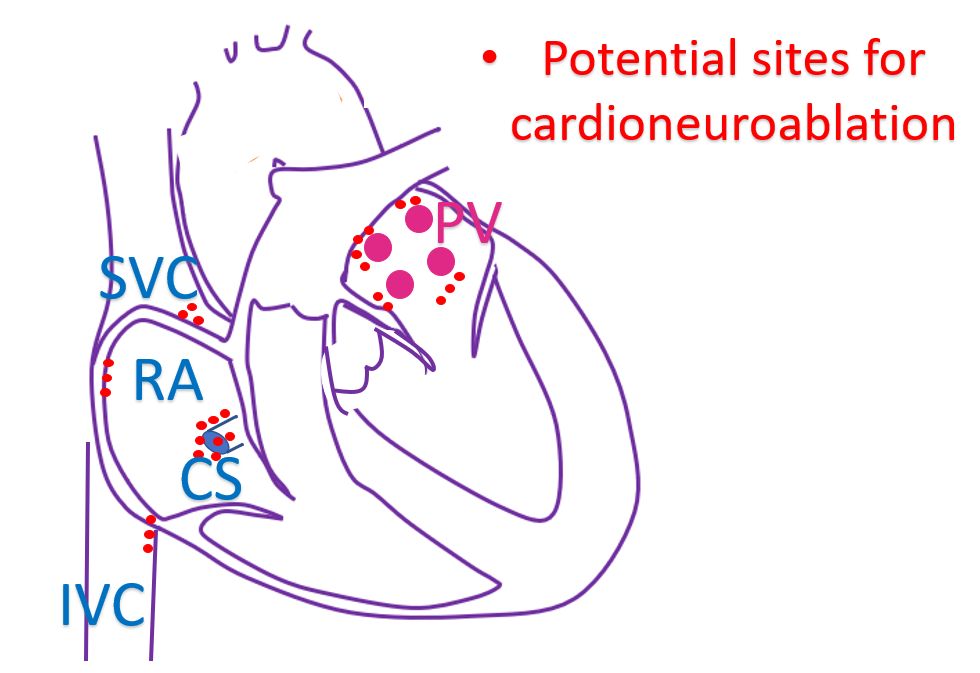Cardioneuroablation for vasovagal syncope
Cardioneuroablation for vasovagal syncope
Cardioneuroablation is a new therapeutic option for often difficult to treat vasovagal syncope. Cardioneuroablation is performed using radiofrequency catheter ablation of ganglionated plexi from the left and right atrium. The first randomized study documenting the efficacy of cardioneuroablation in patients with cardioinhibitory vasovagal syncope has been published as early online in JACC: Clinical Electrophysiology [1].

It was a prospective, open, randomized, controlled, investigator-initiated trial comparing cardioneuroablation with optimal non-pharmacological therapy in patients with cardioinhibitory vasovagal syncope. Patients were included if they had documented symptomatic cardioinhibitory or mixed vasovagal syncope and positive atropine test.
There were a total 48 patients and primary endpoint occurred in 2 patients. Primary endpoint of the study was time to first syncope. Secondary endpoints of the study were changes in sinus rhythm and heart rate variability measured on Holter monitoring at 3, 12 and 24 months after cardioneuroablation and changes in quality of life after completion of follow up.
Mean sinus rate on 24 hour Holter ECG was significantly faster and heart rate variability parameters changed significantly towards parasympathetic withdrawal. There was significant improvement of quality of life in the study group while it remained stable in controls.
An earlier study from the same group of authors had 20 patients who had history of syncope due to asystole confirmed by tilt table testing [2]. The patients had repeat tilt table testing and Holter ECG 3 months after cardioneuroablation. All patients completed one year follow up.
During the one year follow up period, no syncopal episodes were noted. 13 had syncope at the repeat tilt table test while 6 did not. Twelve of the syncopes were of vasodepressor type while one was due to asystole. Mean heart rate after cardioneuroablation was significantly faster and heart rate variability lower. These changes were similar in those who had fainting or not in the second tilt table test.
Other authors have suggested cardioneuroablation for selected cases of other vagally mediated bradyarrhythmias also. These include vagally mediated sinus bradycardia, periods of sinus arrest and variable degree of atrioventricular block [3]. We need larger blinded randomized studies on all these aspects before these can be considered as regular treatment options.
References
- Piotrowski R, Baran J, Sikorska A, et al. Cardioneuroablation for reflex syncope: efficacy and effects on autonomic cardiac regulation- A Prospective Randomized Trial. J Am Coll Cardiol EP. null2022, 0 (0) .
https://doi.org/10.1016/j.jacep.2022.08.011 - Piotrowski R, Żuk A, Baran J, Sikorska A, Kryński T, Kułakowski P. Cardioneuroablation changes the type of vasovagal response in patients with asystolic reflex syncope. Auton Neurosci. 2021 Nov;235:102838. doi: 10.1016/j.autneu.2021.102838. Epub 2021 Jun 24. PMID: 34186273.
- Aksu T, Erdem Guler T. Cardioneuroablation in the Management of Vasovagal Syncope, Sinus Node Dysfunction and Functional Atrioventricular Block: Patient Selection Based on Supporting Evidence. J Atr Fibrillation. 2020 Jun 30;13(1):2396. doi: 10.4022/jafib.2396. PMID: 33024497; PMCID: PMC7533142.
